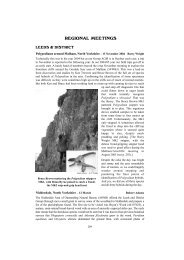Full Contents as pdf File - Natural History Museum
Full Contents as pdf File - Natural History Museum
Full Contents as pdf File - Natural History Museum
You also want an ePaper? Increase the reach of your titles
YUMPU automatically turns print PDFs into web optimized ePapers that Google loves.
TREE-FERN MINI-SYMPOSIUM AT RBG KEW, SURREY – 8 November<br />
Graham Ackers (a.m.) & Pat Acock (p.m.)<br />
For some time it had been our intention to hold an indoor meeting centred around one of the<br />
BPS Special Interest Groups, and this w<strong>as</strong> the first one. The Tree-Fern SIG w<strong>as</strong> started<br />
nearly ten years ago by Martin Rickard and h<strong>as</strong> been run in recent years by Al<strong>as</strong>tair<br />
Wardlaw. The group h<strong>as</strong> been very active, producing a Newsletter and horticultural<br />
surveys. The programme for this meeting w<strong>as</strong> designed to be an overview of tree-fern<br />
biology, with a horticultural bi<strong>as</strong>.<br />
Perhaps appropriately then, Martin Rickard gave the first presentation: ‘Tree-ferns of<br />
temperate lands’. Martin h<strong>as</strong> had wide experience of growing tree-ferns in temperate lands<br />
(i.e. England!), so clearly the talk w<strong>as</strong> angled at relating the wild growing localities and<br />
conditions with actual and potential cultivation viability. A tree-fern world location map<br />
w<strong>as</strong> shown (from 1975 Fern Gazette 11: 74), indicating their pronounced southern<br />
hemisphere distribution (and also showing that most tree-ferns are in fact tropical). Martin<br />
then went on to show slides and discuss tree-fern species from many lands, with special<br />
emph<strong>as</strong>is on those occurring in cold(ish) and/or high altitude locations. Wild plants were<br />
shown from Nevis, Mexico, Chile, South Africa, Papua New Guinea, Australia (various<br />
localities), New Zealand and Hawaii, and locations with cultivated plants included Madeira,<br />
Australia, Gl<strong>as</strong>gow, County Kerry, Hereford and London (Chiswick).<br />
The enticing title of Chris Page’s talk w<strong>as</strong> ‘Why be a tree-fern?’ He described the<br />
advantages and disadvantages of the structure and growth patterns of tree-ferns. In order to<br />
colonise, tree-ferns require large virgin disturbance sites such <strong>as</strong> can result from landslides,<br />
fire etc. Such events do not happen very often, but when they do, spores can start to<br />
germinate and grow very quickly, particularly <strong>as</strong> tree-ferns are edaphic generalists in terms<br />
of substrate requirements. The characteristic tree-fern architecture of a large, high-placed<br />
crown reflects this ability to develop quickly. This enables the plant initially to outstrip<br />
competitors in speed of growth to maintain access to light, and indeed many tree-fern<br />
species are adapted to conditions of high light intensity (compared with other fern groups).<br />
The high-placed crown also allows the effective distribution of spores, which are produced<br />
in very high numbers in tree-ferns, and may be broadc<strong>as</strong>t for each plant over a period of<br />
several hundred years. But not all is ‘good news’, <strong>as</strong> tree-ferns have some disadvantages too.<br />
For example, compared with other ferns, their energy investment is high in making the trunk,<br />
and they are space-demanding, which is not so good in a highly competitive environment.<br />
An interesting link to Martin Rickard’s talk w<strong>as</strong> the thought that the southern bi<strong>as</strong> of treefern<br />
distribution could have resulted from the higher tectonic activity thereby producing<br />
more disturbance sites. Northern hemisphere sites with such activity tend to have unsuitable<br />
climates for tree-ferns – e.g. too dry in the Mediterranean and too cold in the Atl<strong>as</strong> Mountains.<br />
The title of Al<strong>as</strong>tair Wardlaw’s talk ‘A gardener’s view of tree-fern taxonomy’ perhaps<br />
hinted at amateur frustration with some <strong>as</strong>pects of tree-fern identification – for example, a<br />
field botanist knows which country he/she is in (hopefully!), but a gardener buys tree-ferns<br />
on trust. Identification being b<strong>as</strong>ed in part on structure and location of sori, difficulties can<br />
be experienced before a plant produces spores. The importance of scales and hairs for<br />
identification w<strong>as</strong> emph<strong>as</strong>ised and demonstrated in Al<strong>as</strong>tair’s talk. Particularly interesting<br />
w<strong>as</strong> his picture of various tree-fern scales transferred to graph paper. Since regional flor<strong>as</strong><br />
produced by professional botanists rarely compared species to those in other are<strong>as</strong>, it w<strong>as</strong><br />
difficult to gain an understanding of the range of variability and similarities within say<br />
Dicksonia (even more of an issue in the very much larger genus Cyathea in its ‘lumped’<br />
circumscription). However, some publications were felt to be helpful. For example, the<br />
European Garden Flora (1986) includes taxonomic keys, and the recently published Fern<br />
Grower’s Manual (B.J. Hoshizaki & R.C. Moran, 2001) includes pinna outlines of<br />
118

















